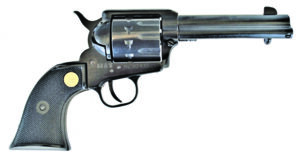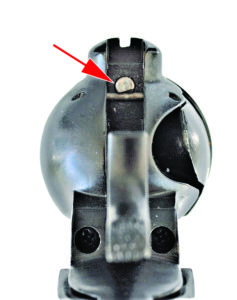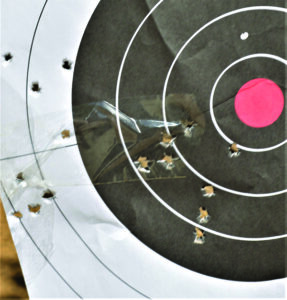Gun Tests Grade: C
$185
The Chiappa single-action revolver features a 10-shot cylinder. It is larger than two of the other revolvers tested because the Chiappa 1873 is closer to the Colt Single Action/Ruger New Vaquero frame size. Because the revolver is constructed of non-ferrous alloys, it remains light for the size. The Chiappa, then, may be said to have more of a genuine Old West feel to it since it is a full-size revolver. The grip feels good in the hand, and the revolver points reasonably well. The finish isn’t a deep, rich blue at all, but is instead some type of matte finish. While we did not expect much from a $170 handgun (our price at the time of the test), the finish is evenly applied and not unattractive. The grips are checkered plastic. The grips are the same size as a Colt Single Action Army. Some Colt grips will fit, but the locating pin isn’t in the same place.
| Action Type | Single action |
| Overall Length | 10.8 in. |
| Overall Height | 5.0 in. |
| Maximum Width | 1.6 in. |
| Weight Unloaded | 32.4 oz. |
| Weight Loaded | 36.4 oz. |
| Cylinder Gap | 0.010 in. |
| Barrel Length | 4.75 in. |
| Capacity | 10 |
| Frame | Blue-anodized alloy |
| Cylinder | Steel-lined alloy |
| 22 Magnum Cylinder | Not included |
| Frame Front Strap Height | 2.1 in. |
| Frame Rear Strap Height | 3.0 in. |
| Grips | Checkered plastic |
| Grip Thickness (Max) | 1.5 in. |
| Grip Circumference (Max) | 5.7 in. |
| Front Sight | Fixed blade |
| Rear Sight | Receiver groove |
| Sight Radius | 6.6 in. |
| Trigger Pull Weight Single Action | 3.2 lbs. |
| Trigger Span | 3.1 in. |
| Safety | None |
| Made In | Italy |
| Warranty | 1 year |
| Website | ChiappaFirearms.com |
| Telephone | (937) 835-5000 |
The Chiappa is loaded by placing the hammer on half cock and opening the loading gate. The cylinder is indexed one chamber at a time. The cartridges are loaded, the gate shut, and the hammer moved to the rear and lowered. To fire the revolver, the hammer is cocked and the trigger pressed. The trigger has more travel than the other revolvers tested before it reaches the sear and drops the hammer, but it isn’t that bad a trigger overall. Trigger compression is 3.2 pounds. We like the trigger weight, but not the break.

While a 22 doesn’t recoil much, the 32.4-ounce 1873 22 doesn’t move at all when it is fired. The Chiappa barrel is a steel sleeve in a non-ferrous alloy cylinder. We hit a snag when we first began to load the Chiappa. The bullet nose would not start in four of the ten cylinders. After a bit of wiggling and work and loading the revolver a half dozen times, this unusual break-in problem disappeared.
The revolver is smooth enough on cocking the hammer. The trigger press is light, and while not crisp, it is acceptable. The move to half cock was another matter. Our resident single-action expert noted that when a single action is placed on half cock, it isn’t proper to tug the hammer slightly to the rear to release and then move it forward to come off half cock. With the revolver on half cock, the shooter should move the hammer completely to the rear, after placing the hammer on half cock, and then lower the hammer. This will prevent the bolt from dragging and marring the cylinder. We followed the proper procedure with the Chiappa, but still had a problem. With the hammer on half cock, we would move the cylinder through loading two chambers and it would stop. We wiggled the hammer and sometimes it allowed movement. Other times, the hammer was pulled to a position before the half-cock notch, and we spun the cylinder, but we had to awkwardly hold the hammer as we spun the cylinder. This wouldn’t do. We managed to move the hammer to half cock properly, and, after a time, we were successful more often than not in properly indexing the cylinder. The problem never disappeared.

The Chiappa 1873 isn’t a transfer-bar-equipped revolver. The firing pin is a floating type mounted in the frame. As s
uch, the revolver is not safe to carry fully loaded. While primarily a range gun and plinker, this advice must always be heeded. The old rule of making a revolver safe was modified in this case. The six-shot revolver demands that the hammer be placed on half cock, the first cartridge loaded, a chamber skipped, four cartridges loaded, and the hammer cocked. It will be lowered on an empty cylinder. This was modified with the ten-shot Chiappa 1873. We loaded one, skipped one, loaded eight and lowered the hammer on an empty chamber. Be certain to understand this technique and to never carry this revolver fully loaded. In comparison to the revolvers that may be carried fully loaded, the Chiappa was rated down a full grade. This may not be important for a plinker, but we feel that for a trail gun or small-game revolver and simple safety, this is important.

Firing tests were undertaken with three loadings. We used the Fiocchi 40-grain high-velocity round, Winchester’s 37-grain Super X hollowpoint, and the Federal Hunter Match. We elected to do two basic drills before accuracy testing. We would fire the revolvers as quickly as possible at 10 yards. This told us a lot about balance and the smoothness of the action. We fired more than 200 cartridges in this manner in each firearm. Next, we fired standing, offhand, at 15 yards, at small targets in a plinking situation. We fired minimum of 50 rounds in each revolver in this phase. Next, we fired the obligatory 25-yard benchrest firing test. Firing off hand, quickly, we used the Fiocchi load exclusively. The Chiappa 1873 is smooth enough when shooting offhand, with an easy-cocking hammer and smooth trigger. During the plinking and accuracy stages, however, we noted that the revolver fired low and to the left. This isn’t easy to fix. As one of the gunsmiths on the team noted, he would never attempt to move the barrel of a zinc-alloy-frame revolver, and you cannot bend the sight. You may file a sight to raise the point of impact. Despite these shortcomings, the revolver was reasonably accurate. Fired from the benchrest at 25 yards, the Chiappa 1873 produced five-shot groups of 3 to 4 inches. This is no more than plinking accuracy. The Chiappa was rated down a half grade as a result.
Our Team Said: In the end, we liked the Chiappa. It felt good and pointed well. It is an acceptable plinker. We used Kentucky windage, holding over and to the right, to get hits. We would not buy this revolver if the Heritage, Traditions, and Ruger models were available.
22 LR RANGE DATA
At right are our test guns. Top to bottom are the Chiappa 1873 No. 340.250 22 LR, the Heritage Rough Rider RR22MB6 Combo 22 LR/22 WMR, the Traditions Rawhide Rancher 22 LR, and the Ruger Wrangler No. 2004 22 LR.| Fiocchi High Velocity 40-grain Plated LRN | Chiappa 1873 | Traditions Rawhide Rancher | Ruger Wrangler | Heritage Rough Rider |
| Average Velocity | 1026 fps | 1003 fps | 989 fps | 1053 fps |
| Muzzle Energy | 93 ft.-lbs. | 89 ft.-lbs. | 87 ft.-lbs. | 98 ft.-lbs. |
| Small Group | 3.0 in. | 2.5 in. | 2.0 in. | 2.3 in. |
| Average Group | 3.5 in. | 3.1 in. | 2.3 in. | 2.7 in. |
| Winchester Super X 37-grain Hollowpoint | Chiappa 1873 | Traditions Rawhide Rancher | Ruger Wrangler | Heritage Rough Rider |
| Average Velocity | 1014 fps | 1022 fps | 1000 fps | 1017 fps |
| Muzzle Energy | 84 ft.-lbs. | 86 ft.-lbs. | 82 ft.-lbs. | 85 ft.-lbs. |
| Small Group | 3.5 in. | 2.6 in. | 1.9 in. | 2.3 in. |
| Average Group | 4.4 in. | 3.4 in. | 2.4 in. | 2.6 in. |
| Federal Hunter Match 40-grain Lead Hollowpoint | Chiappa 1873 | Traditions Rawhide Rancher | Ruger Wrangler | Heritage Rough Rider |
| Average Velocity | 1062 fps | 1050 fps | 1031 fps | 1044 fps |
| Muzzle Energy | 100 ft.-lbs. | 98 ft.-lbs. | 94 ft.-lbs. | 97 ft.-lbs. |
| Small Group | 2.7 in. | 2.8 in. | 2.4 in. | 2.5 in. |
| Average Group | 3.9 in. | 3.6 in. | 2.8 in. | 2.9 in. |


























